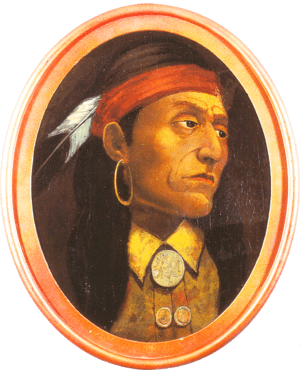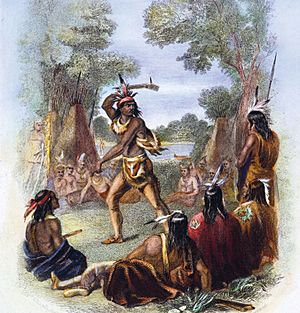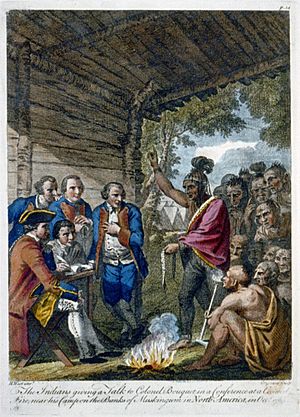Pontiac's War facts for kids

Pontiac's War was a conflict that began in 1763. It involved Native American tribes who were unhappy with British control. This happened in the Great Lakes region and the Ohio Country. The war started after the British won the French and Indian War. Native Americans attacked British forts and settlements in 1763. The fighting mostly ended in 1764 after the British army sent out groups and peace talks began. The war did not make the British leave, but it did make their government change some rules that had caused the fighting.
This war is named after a famous leader, Pontiac, from the Ottawa tribe. Some people used to call it "Pontiac's Rebellion." But historians now mostly use "Pontiac's War." This is because Pontiac was not the only leader, and it was not just a simple rebellion.
One well-known event from the war happened at Fort Pitt. British officers tried to spread smallpox to the attacking Native Americans. They used blankets that had been near sick people.
Contents
Why the War Started
After the French and Indian War, Native Americans felt upset with the British. The French had treated many tribes as friends and partners. But the British treated them more like people they had conquered.
The British general in charge was Jeffrey Amherst. He decided to stop giving gifts to the Native Americans. These gifts were a tradition and helped keep peace. Amherst thought they were just bribes. He also made it harder for Native Americans to get gunpowder and ammunition. They needed these for hunting food and trading furs. Pontiac and other leaders worried the British wanted to control or even destroy them.
At the same time, a new religious movement spread among Native Americans. A prophet named Neolin told his people to stop using European goods. He said they should avoid alcohol and weapons from the white settlers. Neolin combined parts of Christianity with his own beliefs. He told his followers that the Master of Life was unhappy with them. He said they needed to change their ways. This message was powerful for people facing hard times.
The Fighting Begins

The war began near Fort Detroit. Pontiac was a key leader there. The fighting quickly spread to other British forts in the area. Eight forts were captured by Native American attackers. Other forts, like Fort Detroit and Fort Pitt, were surrounded but not taken.
Historians believe this uprising was not planned by one person. Instead, Pontiac's actions at Detroit inspired other unhappy tribes. They decided to fight the British too.
Fighting at Fort Detroit
On April 27, 1763, Pontiac spoke to a group near Detroit. He used Neolin's ideas to inspire them. He convinced Ottawas, Ojibwas, Potawatomis, and Hurons to join him. They planned to take Fort Detroit by surprise.
On May 7, Pontiac and about 300 men entered the fort. They had hidden weapons under their blankets. But the British commander already knew their plan. The 120 British soldiers were ready. Pontiac left the fort and started to surround it two days later. Many British soldiers and settlers outside the fort were captured or killed. More than 900 Native American warriors joined the siege.
In late July, British soldiers arrived to help Fort Detroit. On July 31, 1763, about 250 British tried a surprise attack on Pontiac's camp. But Pontiac was ready. He defeated the British at the Battle of Bloody Run. Still, the fort remained strong. Pontiac's influence over his followers began to weaken. Some groups of Native Americans left the siege. They made peace with the British. On October 31, 1763, Pontiac finally gave up. He realized the French would not help him. He moved away from Detroit but continued to plan against the British.
Fighting at Fort Pitt
Fort Pitt had 330 soldiers and over 200 women and children inside. It was attacked on June 22, 1763, mainly by Delaware Native Americans. The fort was too strong to be taken by force. So, it was surrounded throughout July. Meanwhile, Delaware and Shawnee warriors raided settlements in Pennsylvania. They captured people and killed many settlers. These settlers were living on land that used to belong to Native Americans. Many panicked settlers fled east.
On June 24, 1763, a sad event happened. The commander of Fort Pitt gave two blankets to the Delaware representatives. These blankets had been near people sick with smallpox. The commander hoped to spread the disease to the Native Americans. This was an attempt to end the siege. It is hard to know how many people got sick from this specific event. Smallpox was already in the area. It could have spread in other ways too.
On August 1, 1763, most Native Americans stopped surrounding Fort Pitt. They left to stop 500 British troops marching to the fort. These troops were led by Colonel Henry Bouquet. On August 5, the two groups met at the Battle of Bushy Run. Bouquet fought off the Native American attack. He reached Fort Pitt on August 20, bringing relief to the fort.
Other Fort Attacks
Many other forts were attacked and captured in 1763:
- Fort Sandusky (in Ohio) was taken on May 16, 1763. Wyandot Native Americans pretended to hold a meeting. They then captured the commander and killed the fifteen soldiers. The fort was burned.
- Fort St. Joseph (in Michigan) was captured on May 25, 1763. Potawatomis used the same trick. Most of the fifteen soldiers were killed.
- Fort Miami (in Indiana) fell on May 27, 1763. The commander was tricked outside and shot by Miami Native Americans. The nine soldiers inside surrendered.
- Fort Ouiatanon (in Indiana) was taken on June 1, 1763. Soldiers were invited to a meeting outside. The twenty soldiers were captured without fighting.
- Fort Michilimackinac (in Michigan) was a large fort taken by surprise. On June 4, 1763, Ojibwas played a game of lacrosse with visiting Sauks. Soldiers watched. The ball was hit into the fort. The teams rushed in and grabbed weapons hidden by Native American women. About fifteen soldiers were killed.
- Fort Venango (in Pennsylvania) was taken around June 16, 1763. Senecas killed all twelve soldiers there.
- Fort Le Boeuf (in Pennsylvania) was attacked on June 18. Most of the twelve soldiers escaped to Fort Pitt.
- Fort Presque Isle (in Pennsylvania) was surrounded on June 19, 1763. About 250 Ottawas, Ojibwas, Wyandots, and Senecas attacked it. After two days, the sixty soldiers surrendered. They were promised safe passage to Fort Pitt. But most were killed after leaving the fort.
Fort Niagara was a very important fort. It was not directly attacked. But on September 14, 1763, about 300 Senecas, Ottawas, and Ojibwas attacked a supply train. This happened near Niagara Falls. Two groups of soldiers sent from Fort Niagara were also defeated. Seventy-two soldiers and wagon drivers were killed. This event was called the "Devil's Hole Massacre."
The main attacks on Fort Detroit and Fort Pitt did not succeed. But almost every smaller fort was captured in 1763. About 200 settlers and traders were killed. The British lost about £100,000 in property. The biggest losses were in western Pennsylvania. The total number of Native American losses is not known.
What Happened Next
Pontiac's War made Britain's money problems worse. It also led to the Proclamation of 1763. This new rule stopped colonists from moving west onto Native American lands.
Images for kids
See also
 In Spanish: Rebelión de Pontiac para niños
In Spanish: Rebelión de Pontiac para niños





